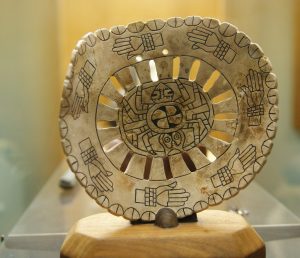 Spiro Mounds Archaeological Center, located on the southern bank of the Arkansas River about a 15-mile drive from Fort Smith, Arkansas, is the only Pre-Columbian Native American archaeological site in Oklahoma that is open to the public. In addition to its exhibits and gift shop, the center features almost two miles of trails, and guided tours can be arranged.
Spiro Mounds Archaeological Center, located on the southern bank of the Arkansas River about a 15-mile drive from Fort Smith, Arkansas, is the only Pre-Columbian Native American archaeological site in Oklahoma that is open to the public. In addition to its exhibits and gift shop, the center features almost two miles of trails, and guided tours can be arranged.
Unknown to History
The location owes its intact nature to fortune and also the efforts of modern scholarship. Its value unknown to western settlers, the land was given to the Choctaw Nation as farmland following the Civil War, and the Choctaw freedmen recognized and respected the mounds and avoided them. In 1933, the site was leased by a treasure hunters, who began to carelessly dig through the site and sell off many cultural artifacts.
Discovery and Renewal
After their unscrupulous digging was stopped by the Oklahoma Legislature, the site was examined by archaeologists from the University of Oklahoma, but excavation was halted due to World War II. The land was eventually purchased in the 1960s by the U.S. Army Corps of Engineers to furnish into a public site, which opened in 1978.
An Extensive Culture
The Spiro were one of the Caddo tribes, who collectively inhabited parts of Texas, Oklahoma, Arkansas, and Louisiana. Between 800 and around 1600 AD they were part of a broader Mississippian culture whose trade and cultural connections reached through most of North America east of the Rockies. During that time, they also made contacts with other cultures as far away as South America, creating an interconnected society of many distinct tribes.
A Center of Trade
Their location on the Arkansas river gave the Spiro the opportunity to control trade over great distances, and to control the travel of others on the same waterway. By doing so, they gained access to exotic items from distant locations. In addition to crafts from other parts of the Mississippian culture, artifacts found at the site include conch shells from the Gulf Coast, copper from the Great Lakes, and even a piece of black obsidian from what is now Mexico.
Layers of Captured Time
The site consists of 12 mounds, most of these used as platforms for houses or temples, constructed in layers over many generations. The mounds were made of dirt carried in baskets, topped by houses made of wood and clay or mud. The single burial mound that was the site’s cultural heart saw at least 600 burials throughout its history, and the same mound is also the source for most of the valuable artifacts found since.
Introspective Art
In addition to artifacts that served practical or religious purposes, Spiro Mounds also contains artworks that realistically depict the people who actually lived there at the time, providing a rare look at their daily lives. These artworks provide vital clues to the culture, lifestyles, and political structure of a people who had no written tradition.
This site is a great place to visit either as a delve into local history or as part of a longer road trip. To find the perfect Chrysler, Dodge, or Jeep vehicle for your exploration, visit Blue Ribbon car dealership near Fort Smith and Sallisaw today.








